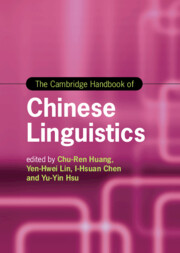Book contents
- The Cambridge Handbook of Chinese Linguistics
- Cambridge Handbooks In Language and Linguistics
- The Cambridge Handbook of Chinese Linguistics
- Copyright page
- Contents
- Figures
- Tables
- Contributors
- Acknowledgments
- Part One Writing System/Neuro-cognitive Processing of Chinese
- Part Two Morpho-lexical Issues in Chinese
- Part Three Phonetic-phonological Issues in Chinese
- 11 The Morphophonology of Chinese Affixation
- 12 Mandarin Chinese Syllable Structure and Phonological Similarity
- 13 Tonal Processes Defined as Articulatory-based Contextual Tonal Variation
- 14 Tonal Processes Defined as Tone Sandhi
- 15 Tonal Processes Conditioned by Morphosyntax
- 16 Tone and Intonation
- 17 Evidence for Stress and Metrical Structure in Chinese
- 18 Perceptual Normalization of Lexical Tones
- Part Four Syntax-semantics, Pragmatics, and Discourse Issues
- Index
- References
16 - Tone and Intonation
from Part Three - Phonetic-phonological Issues in Chinese
Published online by Cambridge University Press: 04 August 2022
- The Cambridge Handbook of Chinese Linguistics
- Cambridge Handbooks In Language and Linguistics
- The Cambridge Handbook of Chinese Linguistics
- Copyright page
- Contents
- Figures
- Tables
- Contributors
- Acknowledgments
- Part One Writing System/Neuro-cognitive Processing of Chinese
- Part Two Morpho-lexical Issues in Chinese
- Part Three Phonetic-phonological Issues in Chinese
- 11 The Morphophonology of Chinese Affixation
- 12 Mandarin Chinese Syllable Structure and Phonological Similarity
- 13 Tonal Processes Defined as Articulatory-based Contextual Tonal Variation
- 14 Tonal Processes Defined as Tone Sandhi
- 15 Tonal Processes Conditioned by Morphosyntax
- 16 Tone and Intonation
- 17 Evidence for Stress and Metrical Structure in Chinese
- 18 Perceptual Normalization of Lexical Tones
- Part Four Syntax-semantics, Pragmatics, and Discourse Issues
- Index
- References
Summary
The primary goal of this chapter is to present the state of the art on Chinese intonation research, with a focus on how tone and intonation interact. To this end, the general functions and forms of intonation observed in (Mandarin) Chinese are first introduced. This is followed by a detailed discussion of the multiplexing of the f0 channel for tone and intonation in varieties of Chinese as well as the different proposals posited for intonation modeling. The secondary goal of this chapter is to highlight open issues and suggest potential points for future research on intonation in Chinese.
Keywords
- Type
- Chapter
- Information
- The Cambridge Handbook of Chinese Linguistics , pp. 336 - 360Publisher: Cambridge University PressPrint publication year: 2022



